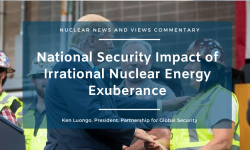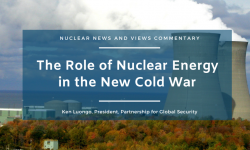As the world meets this week in Vienna to review the global nuclear landscape, the grim reality of Russia’s attacks on Ukraine’s nuclear power plants and Putin's nuclear weapons threats will dominate the discussion.
But lurking behind the headlines at the annual IAEA General Conference is the growing importance of nuclear energy as a response to global zero-carbon and energy security demands. Unfortunately, an effective strategy for how to meet this moment is missing.
The U.S. epitomizes the disconnect. It is investing billions in new nuclear technology programs designed to develop and demonstrate next-generation reactors and fuels. But its technology enthusiasm has swamped needed attention to the parallel policy superstructure that can develop and support the international market for these new reactors.
Unfortunately, at almost two years into its term, beset with major international challenges, and facing a tough mid-term election landscape, it is unlikely that the Biden administration will be able to produce an effective nuclear export strategy beyond sustaining current underperforming approaches.
However, it could strengthen its position on nuclear exports by pursuing a streamlined strategy with three simple objectives:
· Keep Russia down
· Keep China out
· Keep democratic suppliers strong
None of these objectives will be easy, but embracing them sends an important signal to nuclear technology purchasers, potential partners, and geopolitical competitors.
Keeping Russia down as a global nuclear exporter has been the unachievable goal of multiple American administrations. Russia has been the world’s dominant nuclear supplier for years and there seemingly was no leverage to dislodge it. However, Russia’s inexcusable actions in Ukraine have slowed its global nuclear steamroller.
Its attacks at the Zaporizhzhia nuclear reactor complex and other nuclear facilities, the growing international outrage over these and other atrocities in Ukraine, and the deep wounding of Russia’s credentials as a responsible civil nuclear nation, have caused some nations to end nuclear contracts and seek alternatives to Russian fuel supplies.
This opens the opportunity for democratic nations to fill the gap. But they will have to keep China from replacing Russia.
One of Russia’s most significant advantages in the global nuclear market has been its generous state-financed offerings, which make it easier for nations to afford expensive reactors and related infrastructure. But even if Russia is knocked off of its nuclear export throne, similar financial incentives are available from China.
China has the most ambitious plans of any nation for nuclear build-out at home. That sustains robust supply chains and provides valuable construction and operational experience.
This domestic dominance has not yet translated to China’s ability to widely export reactor technologies abroad. Its market penetration has been limited to Pakistan and it is working on a joint plan with Argentina. Its nuclear export ambitions also have been stymied in Britain and Central and Eastern Europe.
But the Middle East remains a potential market for China. Saudi Arabia is once again moving forward with its reactor plans, and China has been invited to bid on the project, while the U.S. has been excluded from this recent tender. China-Saudi nuclear cooperation in the explosive Middle East is a troubling prospect.
China has another advantage. It has created a global web of infrastructure and energy dependency throughout the developing economy world through the Belt and Road Initiative. BRI has been a concern for western nations for a decade. And a number of BRI nations are well-suited for deployment of smaller, next-gen nuclear reactors that China and a number of other nations are developing.
However, the global economic slowdown seems to be causing China to rethink this massive lending program.
If China pulls back from its overextended financing abroad, and Russia is maneuvered to the sidelines of nuclear export as a result of Ukraine, then the path should open for democratic nation nuclear suppliers to reestablish their once dominant position in the global market, to which they could provide both large and small plants.
But instead of developing the necessary plan for how to collaborate to fulfill the nascent nuclear needs of the world, key democratic nation exporters are feuding with one another.
The most glaring example is the U.S. and South Korea. Their major nuclear companies are engaged in a three-year-long dispute over reactor component intellectual property rights. The fight is frozen but has spilled over and restricted research collaboration at the scientific level, hampering innovation at a critical juncture.
This is not an esoteric issue. It is central to democratic nations’ nuclear export competitiveness.
The U.S. and South Korea have partnered on important nuclear reactor projects, including most recently in the UAE. They have symbiotic technological capabilities and supply chains. The large reactor markets in Eastern and Central Europe and the Middle East are potentially too big for either nation to service alone. And the small modular and advanced reactor market is potentially expansive. So, working together makes sense.
Yet, despite a Biden-Yoon presidential summit in Seoul earlier this year and Vice President Harris’ visit to Korea this week, no discernible progress on the IP dispute has been made. That hints at a lack of prioritization by the administration at a time when opportunity is knocking.
There also has been little evidence of strategy collaborations with other key democratic supplier nations, including France, Japan, Canada, and the U.K. This is a serious lapse at a critical time and the Vienna meeting was an ideal environment in which to have these discussions.
Coming into the Vienna meeting, the U.S. underscored that, “our collective climate security and energy security will grow alongside innovation and expansion of civil nuclear power.” It also offered hope that, “for those countries held hostage by Russian fossil fuels right now, nuclear power – freed of Russian supply chains – is part of the solution to sever that dependence.”
While these rhetorical goals are strong and clear, the current strategy to achieve them is anything but that. It is at this nexus where talk turns to action that the U.S. nuclear export commitment is melting down.
To change the nuclear export strategy from mediocre to meaningful, the U.S. and its allies should focus on three streamlined and essential objectives. Combined, they can power resurgent Western nuclear technology exports, high nuclear governance standards, and expansive clean energy. That’s what Western governments have been asking for and the time to act is now.
Ken Luongo, President, Partnership for Global Security





